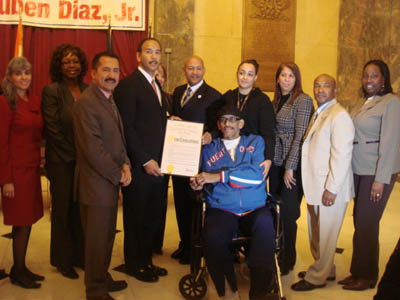Bronx Borough President Ruben Diaz Jr. presented a proclamation to The Bronx HIV CARE Network/Montefiore Medical Center as part of the commemoration of the National Latino AIDS Awareness Day 2009 (NLAAD), an initiative by the Hispanic Federation, the Latino Commission on AIDS and over 250 national organizations promoting AIDS prevention.

(From left) Adriene Rosell, Casa Promesa, Guillermo Chacon, Latino Commission on AIDS, Ruben Diaz Jr., Bronx Borough President,Socrates Cabas, Bronx HIV CARE Network, Richard Nadal, activist and HIV positive, and his daughter, Victor Rivera, Bronx Parents Housing Network, and Daysy Rodriguez, Montefiore Medical Center
AIDS is the third leading cause of death among Latinos in The Bronx. Our borough has more adults diagnosed with AIDS than forty-three states and more people living with this disease than forty-five states. Latinas comprise 51% of people living with HIV and AIDS in The Bronx, and 34.5% of adults diagnosed with AIDS in our borough, higher than any other borough.
“HIV/AIDS is a national issue but in The Bronx it is a crisis. The statistics of Hispanic diagnosed with the illness are truly disturbing,” said Borough President Diaz Jr. “We need to do more to fight this crisis.”
Díaz Jr. commented about the importance of campaigns like The Bronx Knows, a borough-wide initiative to encourage people to undergo HIV testing at one of the number of clinics around the area.
“Getting tested is easy, fast and free in almost all the hospitals of the city, as well as in clinics and community centers. Bronxites need to understand that knowing their status is one of the best things they can do to stop the spread of HIV,” added Diaz Jr.
The theme for NLAAD 2009, United We Can Stop HIV & Prevent, speaks to the importance of working together as a united community to foster collaboration and service integration in an effort to improve the accessibility of quality HIV/AIDS services to Hispanic/Latino communities throughout the U.S.
The National Latino AIDS Awareness Day is intended to promote HIV prevention efforts in the Latino community that are culturally and linguistically appropriate and effective and to support efforts to overcome the stigma and discrimination that often accompanies the disease. The day will be commemorated with activities in the borough, reflecting the depth of commitment by elected officials, health care providers, community based organizations, religious leaders, artists and other Latino community leaders.
